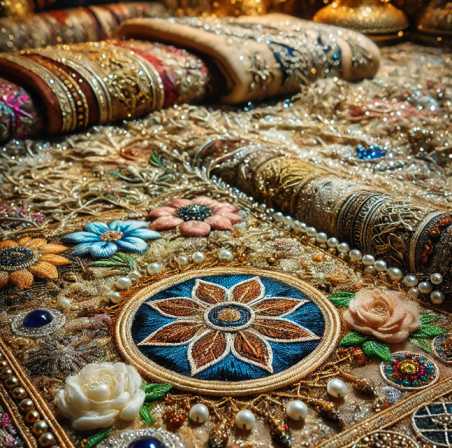A Stitch in Time: Embellishments and Embroidery
Embroidery and embellishments have long been cherished as art forms that combine creativity, craftsmanship, and cultural heritage. From intricate hand-stitched designs to dazzling beadwork and sequins, these techniques add depth, texture, and personal expression to garments, home décor, and artwork. With roots tracing back to ancient civilizations, embroidery has evolved across cultures, becoming a timeless element in both traditional attire and high fashion. Today, it continues to captivate artisans and enthusiasts alike, blending history with modern innovation. This article delves into the extensive historical background, varied methods, and lasting importance of adornments and stitching in the realms of fashion, art, and more.
From Ancient Stitches to Modern Art
Embroidery and embellishments boast a rich history that spans thousands of years and numerous cultures. Originating in ancient civilizations like China, Egypt, and Persia, early embroidery served both functional and decorative purposes, often reflecting the status and identity of individuals. In medieval Europe, embroidery became a symbol of wealth and artistry, with intricate designs adorning church vestments and royal garments. The Renaissance period saw the emergence of elaborate techniques, such as goldwork and silk shading, which elevated embroidery to an esteemed craft.
Globally, unique styles emerged, such as Japanese Sashiko, known for its geometric patterns, and Indian Zardozi, featuring gold and silver thread. Each culture infused its beliefs and traditions into its embroidery practices, making them deeply significant. As time progressed, these crafts adapted, influencing modern fashion and design while retaining their historical essence. Today, embroidery celebrates heritage, creativity, and individuality, bridging the past with contemporary expression.
Different Types of Embellishments in Embroidery
- Threadwork: Various thread types, including cotton, silk, and metallic, create different textures and effects in embroidery.
- Beadwork: Incorporating beads adds dimension and sparkle, enhancing the visual appeal of designs.
- Sequins: These shiny discs are often sewn onto fabric to catch the light, creating a glamorous effect.
- Appliqué: This technique involves stitching fabric shapes onto a base fabric, allowing for creative layering and design.
- Patchwork: Combining pieces of fabric into a cohesive design, patchwork showcases color and texture variety.
- Trims and Laces: Adding lace or decorative trims can enhance the elegance of embroidered pieces and provide intricate detailing.
Tools and Materials
- Needles: Specialized embroidery needles come in various sizes and types, including embroidery, crewels, and beading needles, designed for different thread types and fabric weights.
- Embroidery Hoops: These circular frames hold the fabric taut, ensuring precision and ease during stitching.
- Fabrics: Common choices include cotton, linen, silk, and canvas. Each fabric type offers different textures and suitability for various embroidery techniques.
- Threads: Various threads are used, such as cotton floss, silk, metallic, and perle cotton, each offering unique finishes and effects.
- Embroidery Scissors: Small, sharp scissors allow for precise cutting of threads and fabric, essential for clean finishes.
- Stabilizers: These materials support the fabric during stitching, preventing puckering and distortion, especially on stretchy or delicate fabrics.
- Embroidery Marking Tools: Pens, chalk, or disappearing ink markers help transfer designs onto fabric for accurate stitching.
- Embellishment Supplies: Beads, sequins, patches, and lace add extra flair to embroidered pieces, allowing for personalized and creative touches.
Textile Tales
- Identity and Tradition: Many cultures use embroidery to convey identity, reflecting regional styles, symbols, and patterns unique to specific communities. Traditional garments often feature distinct embroidery styles that signify cultural pride and continuity.
- Ritual and Ceremony: In numerous cultures, embroidered textiles play vital roles in rituals and ceremonies. For instance, intricate wedding dresses adorned with traditional embroidery symbolize the union of families and the continuation of cultural practices.
- Artistic Expression: Embroidery serves as a canvas for artistic creativity, allowing artisans to showcase their skills and express personal or communal narratives through colors, motifs, and techniques.
- Economic Importance: In many regions, embroidery is a source of livelihood, providing economic opportunities for artisans and preserving traditional crafts. This contributes to the sustainability of cultural heritage while supporting local economies.
- Global Influence: As cultures interact and merge, embroidery techniques and styles have transcended borders, enriching global fashion and art. This exchange fosters appreciation and understanding of diverse cultures, promoting a sense of shared humanity.
Artistry in Fashion
- Haute Couture: High-fashion designers often use intricate embroidery and embellishments to create luxurious, one-of-a-kind pieces that stand out on runways and red carpets.
- Casual Wear: Embroidery is increasingly popular in casual clothing, from t-shirts to jeans, allowing everyday outfits to exhibit personality and style.
- Accessories: Embellished bags, shoes, and hats provide subtle yet impactful ways to incorporate embroidery into a look without overwhelming the outfit.
- Layering Techniques: Designers often layer embroidered pieces over simple basics, creating visual interest and texture while allowing the embroidery to take center stage.
- Seasonal Collections: Many fashion brands release seasonal collections featuring embroidery that reflects current trends, cultural themes, or artistic inspirations, showcasing its versatility.
- Sustainable Fashion: As sustainability becomes a priority, upcycling and embroidery techniques are being employed to transform old garments into new fashion statements, promoting eco-consciousness.
- Personalization: Custom embroidery services allow consumers to personalize their clothing, making unique statements that reflect their identity and preferences.
- Fashion Collaborations: Collaborations between designers and artisans often lead to innovative uses of traditional embroidery techniques, merging modern aesthetics with cultural heritage.
Final Threads
The use of embroidery and embellishments extends beyond decoration, as they hold deep cultural and historical importance. As versatile tools of expression, they enhance both traditional and contemporary fashion, allowing designers and artisans to showcase their creativity and individuality. From haute couture to casual wear, these techniques bridge the past and present, celebrating craftsmanship while adapting to modern trends. As sustainability and personalization become increasingly important in the fashion industry, the appreciation for embroidered and embellished textiles continues to grow. Ultimately, these art forms enrich our lives, connecting us to diverse cultures and histories through the beauty of fabric and thread.


